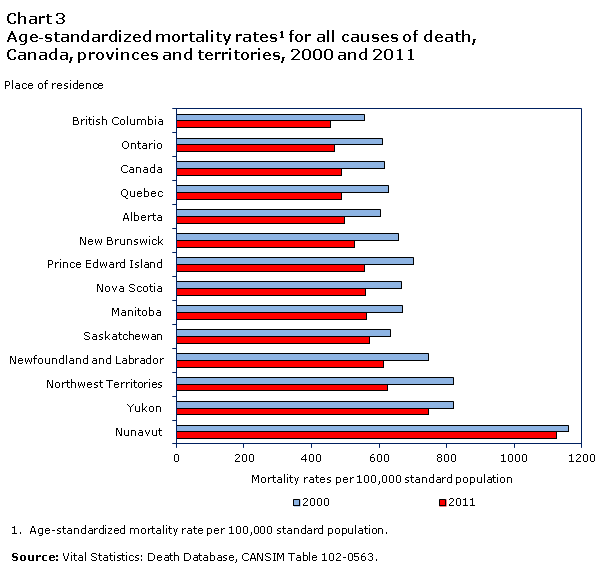Trends in mortality rates, 2000 to 2011
Archived Content
Information identified as archived is provided for reference, research or recordkeeping purposes. It is not subject to the Government of Canada Web Standards and has not been altered or updated since it was archived. Please "contact us" to request a format other than those available.
This fact sheet presents the age-standardized mortality rates and analyzes the trends in mortality rates since 2000, with emphasis on the leading causes of death.
Start of text box.

The age–standardized mortality rates show the number of deaths per 100,000 population that would have occurred in a given area if the age structure of the population of that area was the same as the age structure of a specified standard population. The mortality rates are calculated to eliminate the impact of population structure changes on death rates. Thus, the comparisons of these mortality rates reflect the actual changes in mortality.
End of text box.
For the period 2000 to 2011, the age-standardized mortality rate for all causes combined declined 20.6%, from 615.5 deaths per 100,000 population to 489.0 (Chart 1). The largest reductions occurred from 2005 to 2006 mainly because of the substantial reduction in the rates for heart disease and, to a lesser extent, because of the decline in the rates for stroke and cancer.
Age-standardized mortality rates for all causes of death declined for males by 24.2% (from 778.3 to 589.9) from 2000 to 2011, while rates for females declined by 17.6% (from 493.2 to 406.3).

Age-standardized mortality rates for all 10 leading causes of death declined
Over the period 2000 to 2011, standardized mortality rates declined for all 10 leading causes of death. The standardized rates for stroke (cerebrovascular disease) and heart disease showed the largest decrease, a 41.2% decline (42.2 to 24.8) and a 40.1% decline (152.0 to 91.0) respectively. The mortality rate for accidents (unintentional injuries) had the smallest decrease at 6.2% (25.8 to 24.2). Cancer, the first leading cause of death, saw its rate go down by 14.6%, from 180.4 per 100,000 standard population in 2000 to 154.1 in 2011 (Chart 2).
From 2000 to 2011, the decline in the age-standardized mortality rate for cancer was more pronounced for males (19.0%), from 225.3 to 182.6, compared with the decline for females (10.9%), from 149.4 to 133.1. Meanwhile, the standardized rates for heart disease dropped 41.2% for males (202.9 to 119.3) and 40.4% for females (113.4 to 67.6).

Trends of age-standardized mortality rates varied in provinces and territories
From 2000 to 2011, Ontario and British Columbia had age-standardized mortality rates lower than the Canada-level rate. In 2011, there were 469.3 deaths per 100,000 standard population in Ontario and 454.8 per 100,000 standard population in British Columbia compared with 489.0 deaths per 100,000 standard population for Canada. The rates for Quebec and Alberta have fluctuated around the national level while the other provinces and the three territories had higher mortality rates than the national average (Chart 3).

While cancer has been the first leading cause of death in Canada since 2000, only from 2008 did it become the first leading cause in all provinces and territories. In the provinces, the age-standardized mortality rates for the top three leading causes of death (cancer, heart disease and stroke) decreased over the period of observation.
The decreasing trend was also observed with the mortality rate for chronic lower respiratory diseases in all provinces and territories except Nova Scotia, where the mortality rate fluctuated around 31 deaths per 100,000 population until 2008. Since then, it has increased from 28.7 to 33.3 in 2011.
In general, the age standardized mortality rate for accidents (unintentional injuries) has increased from 2000 to 2011 in Nova Scotia (24.1 to 31.2), New Brunswick (28.7 to 29.4), Ontario (22.3 to 23.8), Manitoba (33.3 to 35.0) and Saskatchewan (36.5 to 40.8). British Columbia started the upward trend in 2006 from 23.4 to 27.0 in 2011. In the other provinces and territories, the mortality rate for accidents has dropped over time.
Data tables
- Date modified:
